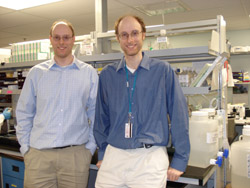
Holy insulin shock, Batman!A dynamic duo tackles diabetes
Shawn Winer wanted to be Spiderman. Actually, scratch that. He still does. His identical twin brother, Dan, however, prefers Batman.

Daniel Winer (left) and Shawn Winer collaborated on research showing that type-2 diabetes might be an autoimmune disease. Photo by Clarissa Cassol.
“At least Batman’s still human,” Dan says, inciting a spirited discussion about spider bites, the Batmobile and Marvel Comics.
It’s not all comic books and online video games, though. The brothers also want to build a time machine. Obviously.
Oh, and they’re 35 years old.
“We’ve always been science geeks,” says Dan, “and we like to think outside the box. We don’t go for dogma.” Rather, Dan and Shawn look for hidden ideas or patterns that may have escaped other people — particularly in human biology and health.
Their most recent discoveries set the world of diabetes care on its head by suggesting that type-2 diabetes, largely believed to be a malfunction of the chemical processes we use to regulate blood sugar, may actually be fueled by a defined autoimmune response. This idea opens the door to new therapies and may even lead to a vaccine to prevent the disorder, which in the United States affects nearly 24 million people.
This tendency to look beyond accepted ideas has served the Canadian brothers well. After graduating at the top of their high school class, the two went to the same college and majored in immunology. Shawn then went on to complete an MD/PhD, studying type-1 diabetes at the University of Toronto, while Dan went to medical school at the University of Ottawa and then to Stanford for research with pathology professor Edgar Engleman, MD. Through it all, the brothers never stopped talking about science and biology.
“We’ve always kept in touch,” says Dan. “We’d play video games online late at night and exchange messages about our research through World of Warcraft.” It was during one of these online gaming sessions that the brothers started wondering whether type-2 diabetes might be influenced by the immune system.
“We both feel that the immune system probably plays a role in almost every disease,” says Shawn. “Think about it. The immune cells in your blood have access to nearly every tissue in your body, and there is no reason to think they don’t influence heavily genetic diseases like Huntington’s or other conditions like type-2 diabetes.”
The brothers’ brainstorm led to two groundbreaking papers in Nature Medicine that have fundamentally changed the idea of how type-2 diabetes develops. One, published in 2009, proved for the first time that an immune cell called a T cell kicks off insulin resistance, the precursor to full-blown diabetes. The other, published in April, showed that another immune cell, called a B cell (and the antibodies it produces), is also involved, probably by attacking the body’s own tissues in a way that impairs the ability of cells to respond to insulin.
Now the brothers are back together, both in the pathology department at Toronto General Hospital — Dan as a new staff member and Shawn as a resident.
“We have almost the same training now,” says Dan. “We each specialized in immunology and pathology. I guess it probably does look like we copied each other. But I don’t think either one of us ever wanted to do anything different.”
Well, that is, except for maybe one thing. Because Shawn devoted extra training time to complete both an MD and a PhD, Dan is now Shawn’s supervisor. And while there’s no proof that Shawn’s looking into that time machine, Dan might want to be cautious.
— Krista Conger


